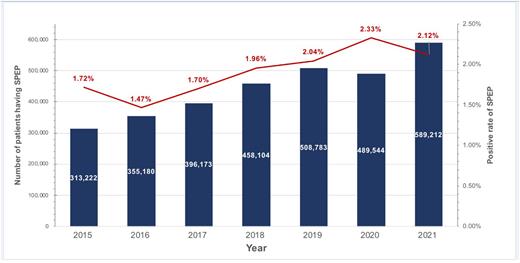Abstract
Background: To improve the early detection rate of multiple myeloma(MM), the M-protein screening system has been performed in hospital population at Zhongshan Hospital Fudan University since 2014, with electrophoretic-based screening integrated into routine blood tests. This study updated the 7-year follow-up findings of MM patients diagnosed by screening-driven and end-organ symptom-driven pattern.
Methods: The retrospective study compared the characteristics and results of two alternative diagnosis patterns by reviewing the plasma cell disease database of MM patients diagnosed between January 2014 and October 2021 at hospital. Screening-driven patients were classified as having an incidental finding of M-protein during workup of unrelated medical conditions or routine body check-up, while symptom-driven patients exhibited myeloma-related end-organ damage's symptoms.
Results: Over 300 million serum protein electrophoresis tests were performed during 7 years, with 1-2 percent yielding positive results, prompting patients to seek further examination. Of 911 confirmed MM cases (concurrent amyloidosis excluded), 366 were assigned to the screening-driven group while 545 were to the symptom-driven group. In comparison to the symptom-driven group, the screening group had more IgG phenotypes (P=0.001), earlier ISS stages(P<0.001), fewer disease-related symptoms (hypercalcemia, renal insufficiency, anemia and bone lesion), lower ECOG scores (P<0.001), less extramedullary disease (P<0.001), a lower rate of bone marrow plasma cells(P<0.001), and lower level of lactate dehydrogenase(LDH)(P=0.018) at baseline. Regarding first-line therapy, it was found that while both groups had comparable exposure to proteasome inhibitor and immunomodulatory drugs as well as rates of the best efficacy, the screening group was more likely to have >2-drug regimens and ≧ 6 induction cycles than the other group. Patients detected through screening had a significantly longer median progression-free survival (PFS) time than the symptom-driven group (62.2 VS 24.9 months) with median follow-ups of 32.9 and 27.8 months, respectively. Furthermore, the screening group did not achieve the median overall survival (OS) time, which was 62.3 months in the symptom group. In multivariate cox analysis, the screening-driven diagnostic pattern remains an independent prognostic factor indicating favorable PFS and OS in MM patients after adjusting for well-acknowledge myeloma prognostic factors.
Conclusion: Routine M-protein screening for MM in hospital patients results in an earlier diagnosis and better patient outcomes in China.
Disclosures
No relevant conflicts of interest to declare.
Author notes
Asterisk with author names denotes non-ASH members.


This feature is available to Subscribers Only
Sign In or Create an Account Close Modal